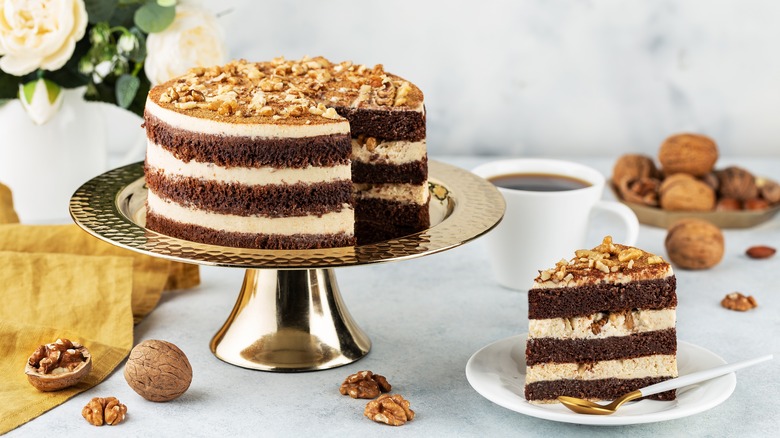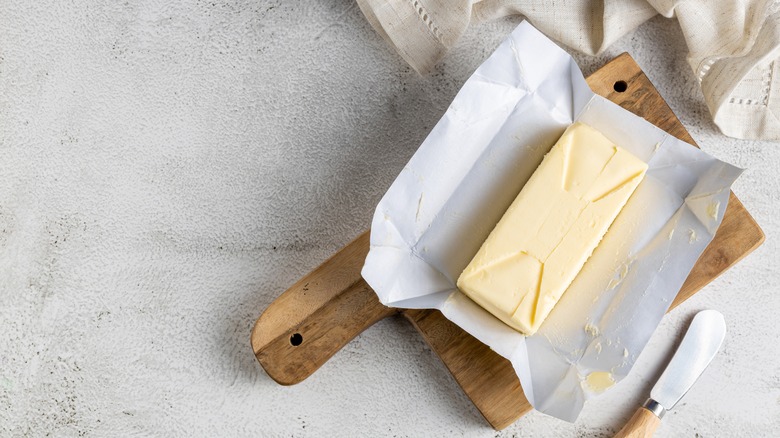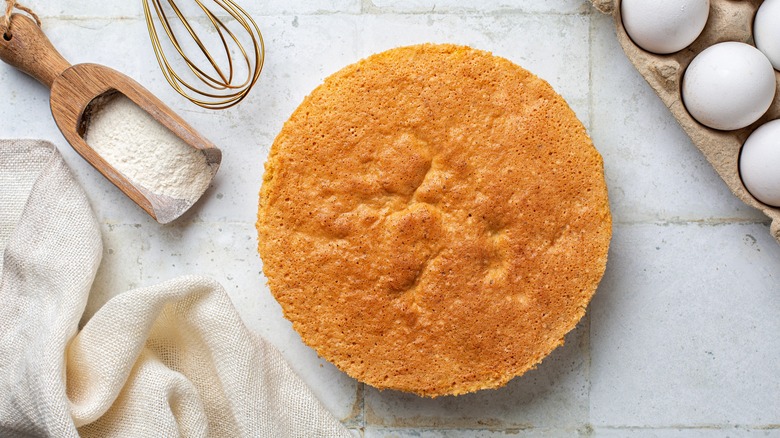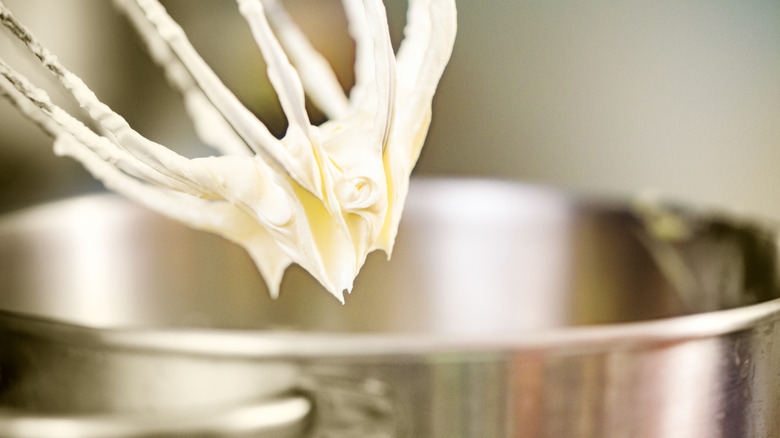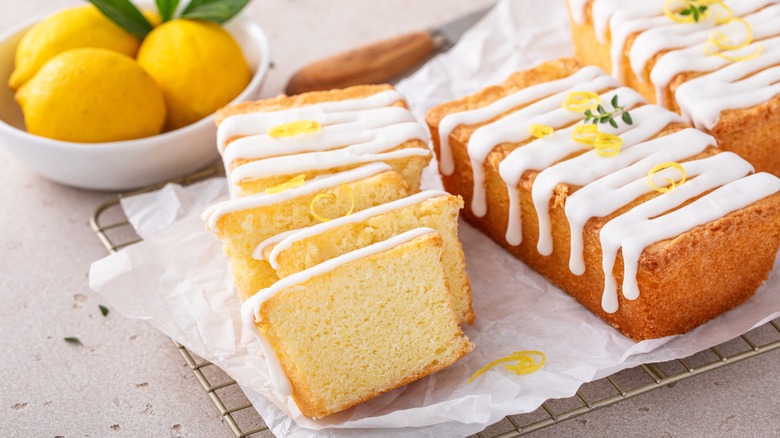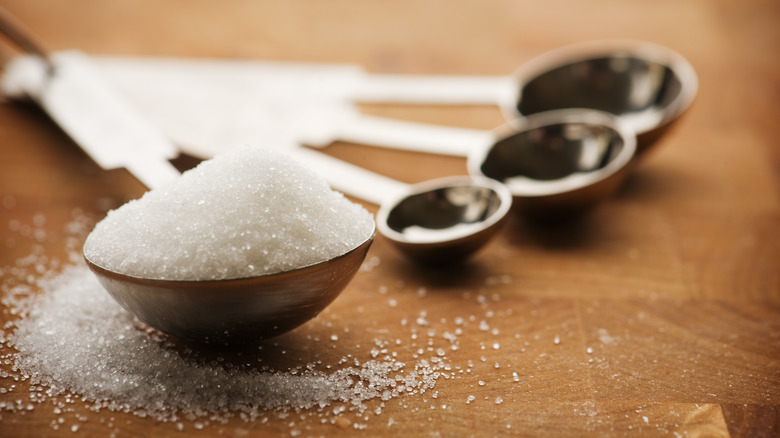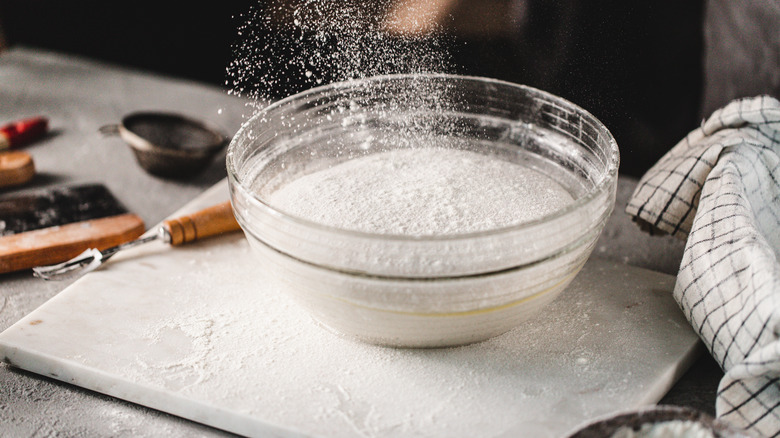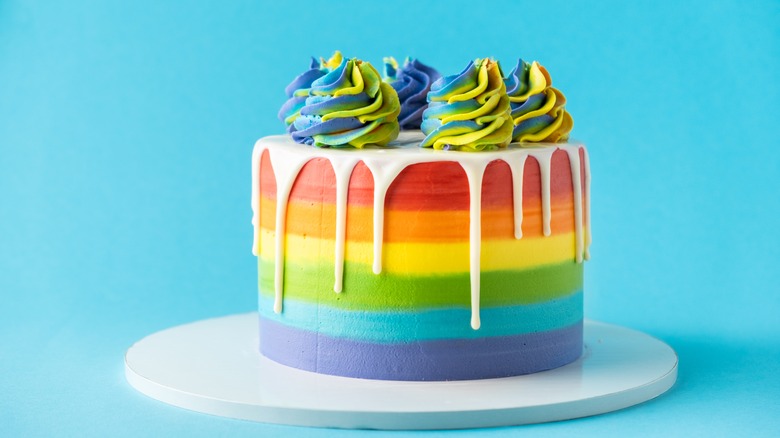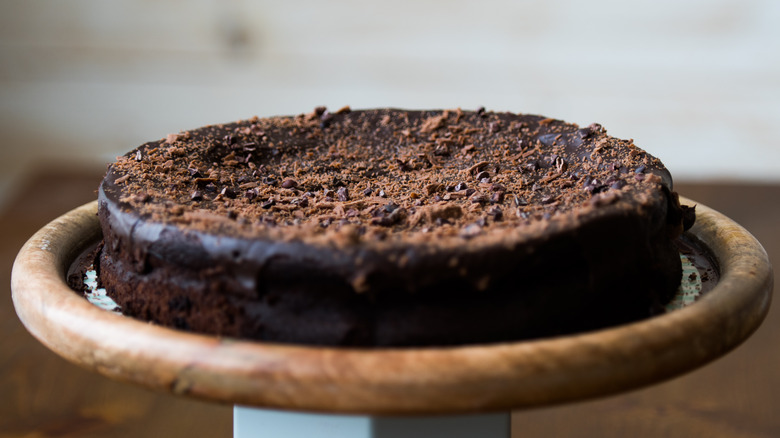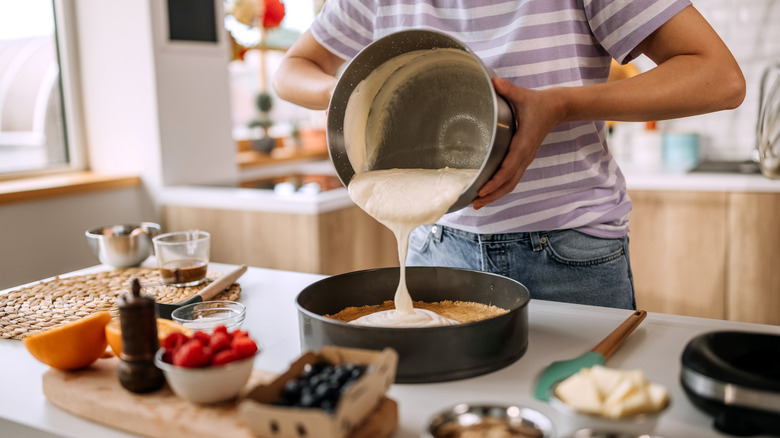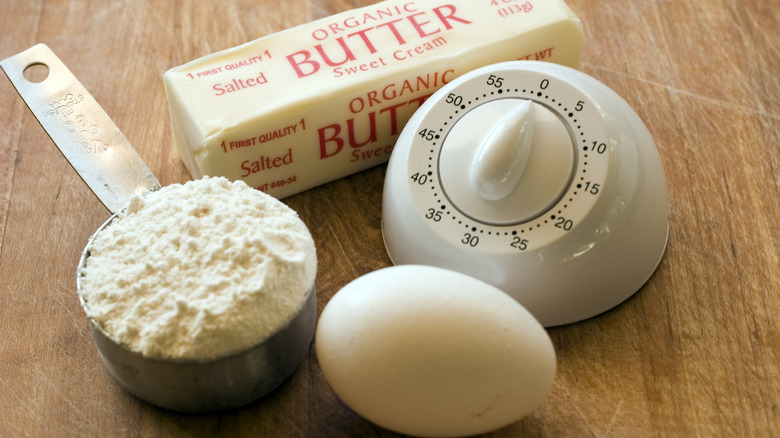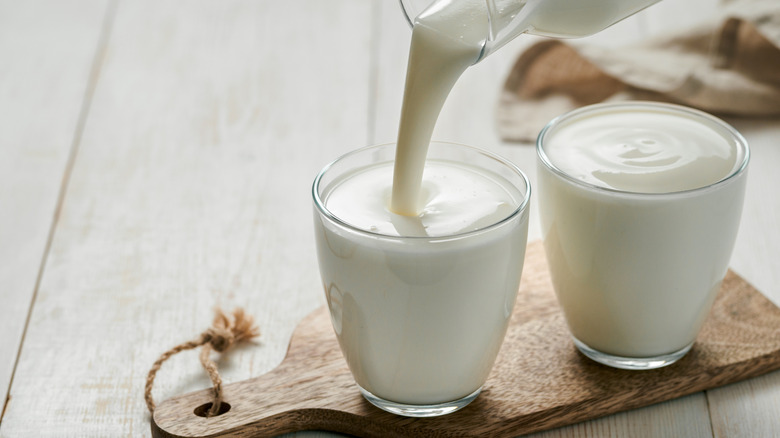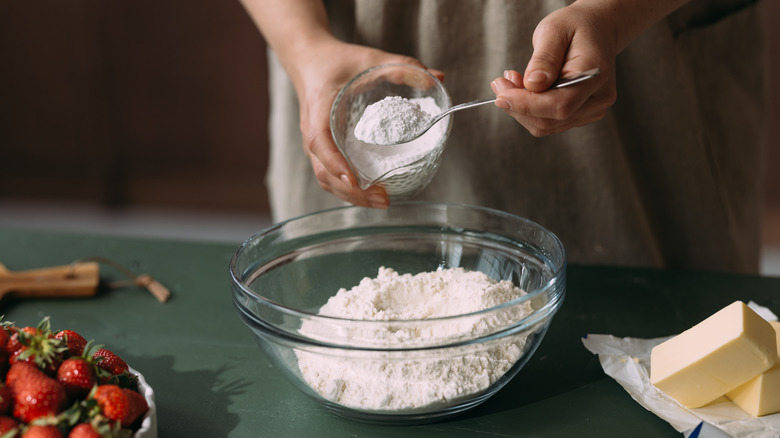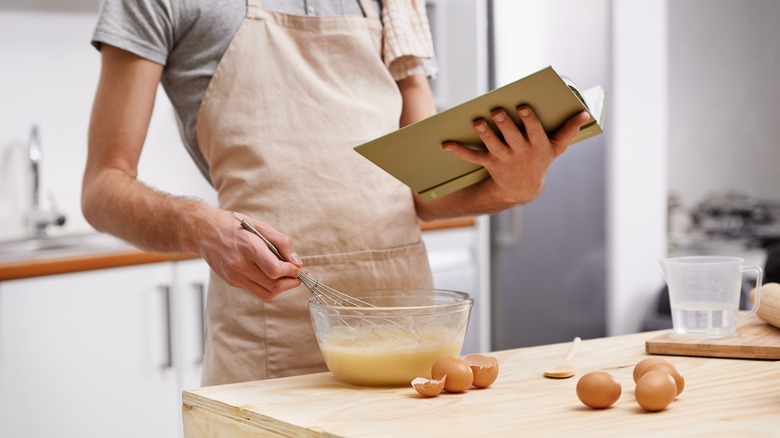13 Cake Myths Debunked
Whether you're throwing a milestone birthday party, celebrating a new job, or simply looking for something to do over the weekend, baking a cake is always a good idea. With a near-infinite number of options, there is something to fit every occasion, from sky-high wedding cakes covered in carefully piped buttercream to fudgy flourless torts oozing melted chocolate. Even within recipes, there is room for creativity. You can add fruit, swap white flour for whole wheat flour, and choose any type of icing you prefer, but no matter what kind of cake you're baking or how seasoned you are as a pastry chef, chances are, you'll run into some confusion at some point.
Just because most home-bakers try their hand at cake-making does not mean that the process is easy or that the conventional wisdom is constructive. You might have heard that you should always cream the butter and sugar first to ensure a light, fluffy cake only to find a recipe that insists that you should mix the butter and flour before adding any other ingredients. Cake-making is plagued with misconceptions that can make an already challenging process confusing and frustrating, but luckily, we've spoken to several experts with a wealth of knowledge on the subject to dispel some of the biggest myths.
1. Myth: Butter is always better than oil
Butter has a one-of-a-kind flavor that just can't be replicated no matter how many products claim to. In many baking recipes, it's the gold standard, and swapping it with oil is a health-conscious compromise that produces lackluster flavor. But according to April Franqueza, pastry chef at High Hampton Resort in North Carolina, oil can actually be the preferred form of fat in some instances. "I like to use oil instead of butter in cakes that I want to have a richer flavor or that need moisture," she explained. Chocolate cake, for example, is prone to dryness because of the cocoa powder, and is, therefore, better when made with oil. She also revealed that she prefers using oil in carrot cake, saying that it's a recipe she likes to make by mixing the oil and eggs without an electric mixer before folding in the dry ingredients.
The reason oil can achieve a rich, moist texture is that it does not contain milk and water, which make up about 20 percent of butter. This excess moisture helps develop the gluten in flour, which in turn makes the structure of cakes made with butter more sturdy. This is desirable when you're trying to create a structured cake that can hold multiple layers and lots of decorations, but not when you want a cake that has a soft, tender crumb.
2. Myth: Freshly baked cakes are best
There are few things that smell as delicious as freshly baked cake, bread, and cookies. And given that cookies and bread are at their most delicious just after they've cooled from the oven, it's logical to conclude that cake would, too. Believe it or not, cake is one of the few baked items that benefit from resting a day or two before being eaten. We spoke with Jasmine Mitchell, the pastry chef and owner behind the bakery J. Carmel's Pastries & Custom Cakes, and she was unequivocal about giving cakes time to sit before serving them. "Trust and believe a resting cake is heavenly!" she said, explaining, "The flavors fuse together and give your tastebuds a pop. I highly recommend and always bake my cakes, wrap them, freeze them, and then frost them."
April Franqueza echoed the sentiment, adding that resting time also helps with your stress levels. "It gives the cake ample time to cool," she explained, "[A]nd then you aren't rushing in order to have it ready the day that you need it." She recommends wrapping the cake layers while they're still slightly warm and thawing them at room temperature a day before you plan to use them. Certain types of cake fare better with aging than others, especially those that have a denser texture and stronger flavor. Carrot cake is a good example, as well as lemon cake, and any other cake centered around citrus.
3. Myth: You should always cream the butter and sugar
Creaming the butter and sugar at the beginning of a cake recipe is second nature for many bakers. It's such a consistent directive that you might not even read the instructions before doing it. But every once in a while, a recipe calls for something different. Before you throw up your hands and question all the conventional wisdom you've ever learned about baking, let's dig into why so many recipes call for creaming the butter and sugar first and why others might choose to mix the butter with the dry ingredients instead.
When you beat butter and sugar together, the sugar crystals dig small channels of air into the butter, making the mixture light and fluffy. When combined with the other ingredients, these small air pockets help the cake rise along with eggs and raising agents like baking powder. Reverse creaming is when you rub the butter into the dry ingredients. During the process, the butter encases the flour with fat, reducing the ability of the gluten to develop and become tough. As a result, cakes that are made with the reverse creaming method have a delicate, tender texture. If you want an airy cake, opt for the classic creaming method. If you want a richer texture, opt for reverse creaming.
4. Myth: More baking powder equals more rise
Most cakes do not use yeast and therefore must rely on other ingredients to achieve an airy rise. In many recipes, the key raising agent is baking powder, a mixture of baking soda, an acid such as cream of tartar, and cornstarch. If you want a little extra oomph in your recipe, doubling up on the baking powder might seem like the obvious solution, but it's likely to do more harm than good. We spoke with cookbook author and pastry chef Saura Kline about why more isn't necessarily better when it comes to raising agents, and she explained that "[a]side from a bitter taste, too much baking powder can cause the cake to rise at a rapid pace then collapse once out of the oven."
Baking powder causes cakes to rise by producing carbon dioxide gas that creates pockets in the structure of the batter. However, the amount of baking powder you use must be in proportion to the other ingredients. Otherwise, the chemical reaction between the raising agent and the moisture in the recipe will occur too rapidly, causing the air pockets in the batter to expand quickly and then collapse before the cake has time to set. Instead of ending up with an airy cake, you'll end up with one that is sagging in the middle and has a metallic flavor.
5. Myth: You only lose sweetness when cutting back on sugar
If you're trying to make your cake healthier, reducing the amount of sugar that the recipe calls for is one of the easiest options. If you choose this route, however, you'll be making a compromise with texture, because sugar plays a much bigger role in cake-making than simply adding sweetness. As Saura Kline explained, "The sugar contributes to the structure as well as the taste. When you cut back on the sugar it will result in a more crumbly texture similar to a biscuit."
One of the reasons for this change is that sugar weakens the tough, rubbery structure of proteins (such as the kind in gluten and eggs) which helps keep the cake tender. It is also a hygroscopic ingredient, meaning that it attracts moisture from its surroundings. As a result, you end up with a cake that is tender and moist — the holy grail of baking. You can cut back on sugar if you want to make the recipe healthier, but keep in mind that the structure will be altered. Swapping brown sugar for white sugar might provide a small advantage since it is more hygroscopic than white sugar.
6. Myth: You should steer clear of bleached flour
"Bleached" is a scary word, implying a chemical process so strong that it strips something of its color. When you're strolling through the baking aisle and see that some bags of flour are bleached while others are unbleached, you might assume that their only difference is color and therefore grab the unbleached option without a second thought. But there are more practical reasons aside from color that you might want to pick bleached flour, and luckily, the chemical process it undergoes isn't nearly as concerning as it sounds.
Bleaching flour is intended to create a chemical reaction, not bathe your key baking ingredient in chlorine. During the process, both the chlorine and the flour are altered, which in turn transforms the cake or batch of cookies you make with them. Chlorine slows down several processes that occur when flour is added to a recipe, including how quickly the starches absorb moisture and how long it takes the proteins in the flour to create a set structure. By slowing these processes, the cake has more time to rise.
7. Myth: Cake is always unhealthy
Cakes are associated with major celebrations in life, such as birthdays, weddings, baby showers, going away parties, and graduation festivities. The stereotypical version is multilayered and covered in icing, the picture of delicious, sugary indulgence. But cakes aren't always unhealthy. Claire Cary, a food photographer and recipe developer whose website Eat With Clarity focuses on gluten-free recipes, said that the nutritional value of a cake all depends on the ingredients you're using. "Cakes that have a base of refined flour and sugar are generally going to lack any sort of nutrition," she explained, "However, we have cakes made from more nutritious ingredients like oat flour, almond flour, protein powder, and sweetened with a natural sweetener such as maple syrup or honey. These types of ingredients are higher in fiber, protein[,] and won't have such a dramatic spike on your blood sugar as a traditional cake."
There are many ways to make a cake healthier, such as using wholegrain flour, adjusting the sugar, and leaving the frosting out of the equation. All of these options will allow you to (if you'll excuse the punny proverb) have your cake and eat it too when it comes to indulgence and nutrition.
8. Myth: Gluten-free cakes can't be light and fluffy
If you've ever gone to the bakery and surveyed the gluten-free options, chances are, they were significantly shorter and denser than the cakes made with gluten. Or maybe you've tried to make gluten-free cakes yourself only to find that they come out of the oven flat and rubbery. These kinds of experiences might lead you to assume that such attributes are inevitable with gluten-free baking, but as Claire Cary explained, several factors can lead to these issues, and they can be avoided. "Bake times can be very finicky with [gluten-free] cakes," she said. "If you under-bake, you run the risk of the center of the cake collapsing, which will lead to a dense, gummy texture. However, if you over-bake, you can have a cake that is dry and lacks a moist crumb. It's a fine balance, but using a toothpick to check the center of the cake for 'doneness' is the best way to ensure even baking."
Another issue she pointed to is ingredient ratios. "If you aren't going to use a scale to weigh your ingredients," she said, "[I]t's very important to 'spoon and level' your dry ingredients. If you scoop right from the bag, you run the risk of having more flour than the recipe actually called for which can lead to a very dry cake. Baking is a science, and an even more exact one when [gluten-free]!"
9. Myth: Cake pans are interchangeable
Cake pans come in many shapes and sizes, all of which suit different recipes and aesthetic preferences. But what you might not know is that variations in the color of the pans can also play a role in how your cake turns out. As April Franqueza explained, "Darker pans will likely absorb more heat, causing the outside of your product to bake faster -– think about when you wear a black t-shirt into the sun versus a white t-shirt; the black t-shirt makes you much hotter faster since it absorbs the [sun's] rays. When baking, it's preferred to use a lighter color pan or stainless steel since stainless steel has the most consistent distribution of heat."
If you only have dark cake pans, however, you don't have to rush out and buy the lightest ones you can find. Instead, reduce the prescribed oven temperature by 25 degrees and check the cake for doneness regularly once it's set. You will likely find that it needs less time than the recipe prescribes.
10. Myth: The recipe tells you how much time you need
Most recipes provide an estimate for how long they will take to execute, but take these with a grain of salt. In reality, cakes can take a long time to make, and if you only allot the amount of time that you see at the top of the recipe, you're likely to end up stressed, behind schedule, and prone to making mistakes due to rushing. As April Franqueza advised, "Allot more time than you think you need for cake baking and icing! Although it [is] easy to follow a recipe and bake a cake, take the time to ensure you have all of your ingredients, read through your recipe, and don't rush yourself! [Give] yourself ample time and space to accomplish the task at hand."
Between reading through a complicated recipe and getting all the ingredients from your pantry, cupboards, and refrigerator, the preamble to baking might take 15 minutes or more, and that doesn't even account for the time it takes to thaw your butter and bring the eggs to room temperature. Since cakes benefit from aging for a day or more anyway, it's best to play it safe and finish them hours ahead of schedule.
11. Myth: You can easily substitute buttermilk
Cake ingredients tend to follow a similar pattern -– sugar, butter (or oil), flour, eggs, salt, baking powder, and milk. Sometimes, however, recipes call for buttermilk rather than milk. This curdled dairy product is not nearly as ubiquitous as milk, which is evidenced by the seemingly endless number of resources on the internet that provide simple substitutes. Milk and lemon juice, yogurt, and kefir are the most common suggestions, but in reality, none of them are ideal. Buttermilk has unique attributes that make it almost impossible to substitute, and it might be better to make a separate recipe altogether than attempt to replace this crucial liquid with something else.
Traditional buttermilk is a byproduct of churning butter, but modern versions are typically made by introducing live cultures to milk. The process is similar to making yogurt and the two products have similar levels of acid, but buttermilk has relatively low levels of lactose and protein, ingredients that create a moist, slightly dense texture. Without them, the acid in buttermilk creates a light, fluffy rise that is crucial to certain recipes. On the flip side, the combination of milk and an acidic ingredient like lemon juice or vinegar is often too acidic, which can lead to a sharp flavor and pale appearance. They also do not have the thick texture of buttermilk, making the batter runny and producing a flat cake.
12. Myth: You should always use cake flour
Bread flour is for bread, cake flour is for cake, and pastry flour is for pastry. It's simple, right? Well, not so much. It turns out that depending on what type of cake you're making and the texture you're hoping to achieve, cake flour might not be the best option. The deciding factor between the many types of flour is their protein content. When the protein in the flour mixes with water, it turns into gluten, which provides elasticity and structure. For this reason, flour that is high in protein is geared toward bread baking, while flour that is low in protein is geared toward baked goods that need a tender structure, such as cake.
Jasmine Mitchell said that she usually uses all-purpose flour for making cakes and only uses cake flour occasionally. "All-purpose flour has a wide range of uses," she explained, "[I]ncluding cakes, cookies, pastries, and a variety of recipes. It can do everything. Cake flour is used for softer cakes like vanilla and white cake. It also has a softer consistency but not a dramatic difference." If you're trying to maximize a tender texture, opt for cake flour, but if you don't have any in your pantry, all-purpose flour will work nicely and provide exactly what you want for most cake recipes.
13. Myth: All you need is a good recipe
When it comes to cake baking, a good recipe is just the starting point, but not the only deciding factor on whether you end up with a result you're pleased with. Anyone can master the art of making cakes, but it takes time and a little trial and error to get there. This is especially the case when you're trying to produce results that are both delicious and aesthetically pleasing. As Jasmine Mitchell told us, making a beautiful and mouthwatering cake is all about "[p]ractice, patience, and more practice."
When she started baking cakes, Mitchell said that she quickly wanted to learn how to improve them, but it wasn't a speedy process. "I started with boxed cakes and boxed frosting, which was fine," she said, "[B]ut I wanted to go to the next level. I had to study, do research, learn science all over again[,] and gain patience." Whether you're making a boxed cake mix or a 10-tiered wedding cake, there is always room for improvement, and it just takes time and practice.
